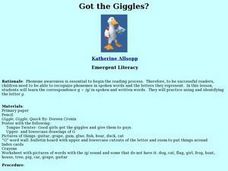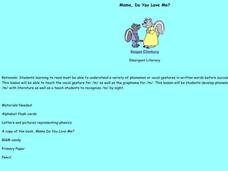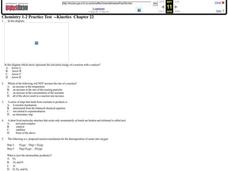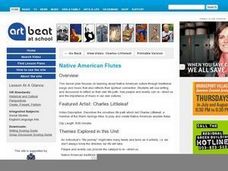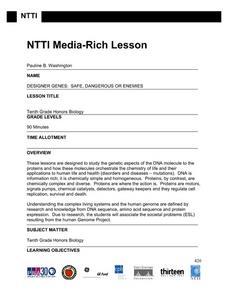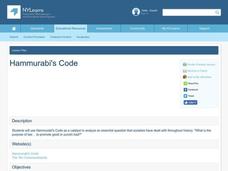Curated OER
Swimmy Swim Swiftly
Students examine the letter 's'. Through instruction and modeling they explore the sound the letter makes, how the letter is written, words that contain the letter, etc. They listen to a story and identify words with the /s/ sound by...
Curated OER
Got the Giggles
Young scholars identify the grapheme and phoneme for G. They practice writing the letter G and through listening activities, discriminate the phoneme /g/. They associate the phoneme /g/ with its letter representation and identify it in...
Curated OER
Cranking Cooky Cars
Students practice the strategy of phoneme awareness with special vocal gestures or sound with the correspondence /k/. They listen as the book, "ABC," by Dr. Seuss is read to them and then they work on a tongue twister and worksheets.
Curated OER
Ohhhh Me, Ohhhhh My!
Students practice identifying phonemes and recognizing letters in written words to become fluent readers. They study the phoneme /O/ in the tongue twister, "Oh No, my Nose needs an operation in October." Each student also interacts with...
Curated OER
Mama, Do You Love Me?
Students complete a variety of activities related to the /m/ sound. As a class, they recite a tongue twister, and play the "I Spy" game for the letter M. Students then listen to the book "Mama, Do You Love Me?" and identify words in...
Curated OER
Silly Sally
First graders identify the grapheme and phoneme for S. They practice writing the letter S and through listening activities, discriminate the phoneme /s/. They associate the phoneme /s/ with its letter representation and identify it as...
Curated OER
Shirley Loves To Shake Her Shakers
Students identify the digraph /sh/ in written and spoken language. After a brief discussion of the independent and combined sounds of the phonemes /s/ and /h/ students practice identifying initial and final placement of the new digraph...
Curated OER
Thumped
Second graders identify the digraph /th/ in written and spoken language. After a brief discussion of the independent and combined sounds of the phonemes /t/ and /h/ students practice identifying initial and final placement of the new...
Curated OER
Elmer the Elephant
First graders recognize the short vowel E in written and spoken language. Through matching activities, they discriminate the short vowel /e/ from other phonemes. Students associate the phoneme with its letter representation and spell...
Curated OER
Howwwwl At The Moon
Young scholars explore vowel digraphs. They discuss what a vowel digraph is and discuss the vowel digraph ou=/ow/. Students read "The Napping House." They practice spelling words with the /ow/ sound in them. Young scholars read words...
Curated OER
Wow, That's Loud!
Students explore vowel digraphs. They discuss the vowel digraph ou=/ow/. Students identify ou=/ow/ in spoken and written words. They read words with the ou digraph and practice spelling words that contain the ou=/ow/ digraph.
Curated OER
Ow! That Hurts
Students study the ou=/ow/ correspondence in written and spoken words using a tongue twisters and a letterbox lesson. They recite the tongue twister and make given words using the letterboxes. Next, they listen to a read aloud of Audrey...
Curated OER
What's All the Buzz about .... Reading!
Learners use fluency checklists in this lesson to improve oral reading ability. The teacher models fluent and timed reading while reading the story "Fuzz and the Buzz." The students work with a partner to time each others oral reading...
Curated OER
Reading Like Wild Animals!
Pupils read orally a number of times to increase oral reading speed and fluency. The teacher models fluent oral reading, and the students practice on sample sentences. They then read with a partner working to increase their oral...
Curated OER
Read Like Sonic the Hedgehog
Students investigate the benefits of rereading books to increase reading fluency and comprehension in this activity. They practice saying site words orally as quickly as they can. They then work with a partner reading a story multiple...
Curated OER
American Expression
Students exercise the strategy of reading more fluently with expression through practice and recognizing punctuation marks when reading. They read with expression the book, Guess How Much I Love You by Sam McBratney and a variety of...
Curated OER
Hip Hip Hooray for Expression!!
Students identify what it means to be fluent and that there are five components: reading faster, reading with expression, reading smoothly, reading silently and being able to read voluntarily. Then they focus on being able to read with...
Curated OER
Role Playing for Fluency
Learners explore the benefits of rereading a story to increase their oral reading speed, fluency, and comprehension. They work with a partner reading the story "What Will the Seal Eat?" They time and encourage each other in each...
Curated OER
Shhh!!! I'm Reading!
Students practice reading silently decodable texts in this lesson. They discuss the importance of being able to read silently. They then practice silently reading "Wemberly Worried." An assessment/checklist is included in this lesson.
Curated OER
Kinetics
In this kinetics worksheet, students review activation energy, rate of reaction, and reaction mechanisms. This worksheet has 13 multiple choice questions.
Curated OER
Native American Flutes - Activity 1
Students discuss Native American culture and musical techniques after viewing a video of Charles Littleleaf, a member of the Warm Springs tribe and a creator of Native American wood flutes.
Curated OER
Temperature and the Tomato
You will need a photovoltaic system and monitor at your school in order to obtain all of the data required to thoroughly implement this lesson plan. Your class monitors daily temperature and insolation amounts over a two week span of...
Curated OER
Personal Travel Guide to a Chinese City
Scholars become travel guides in this group research project to investigate a Chinese city or region for a presentation. Heavily based on Internet research, the activity requires participants to jigsaw the final project, so each team...
Curated OER
Hammurabi's Code
Students compare and contrast Hammurabi's Code and the Ten Commandments. They discuss the purpose for rules. Students examine the first written laws by King Hammurabi and the Ten Commandments. Students discover the inequalities in...
Other popular searches
- Enzyme Catalysts
- Kinetics Catalysts
- Worksheet on Catalysts
- Catalysts in Photosynthesis
- Nickel Catalysts
- Catalysts and Inhibitors
- Chemistry Catalysts
- World War I Catalysts
- Catalysts and Plants
- Catalysts Worksheets"
- Catalysts Worksheets

